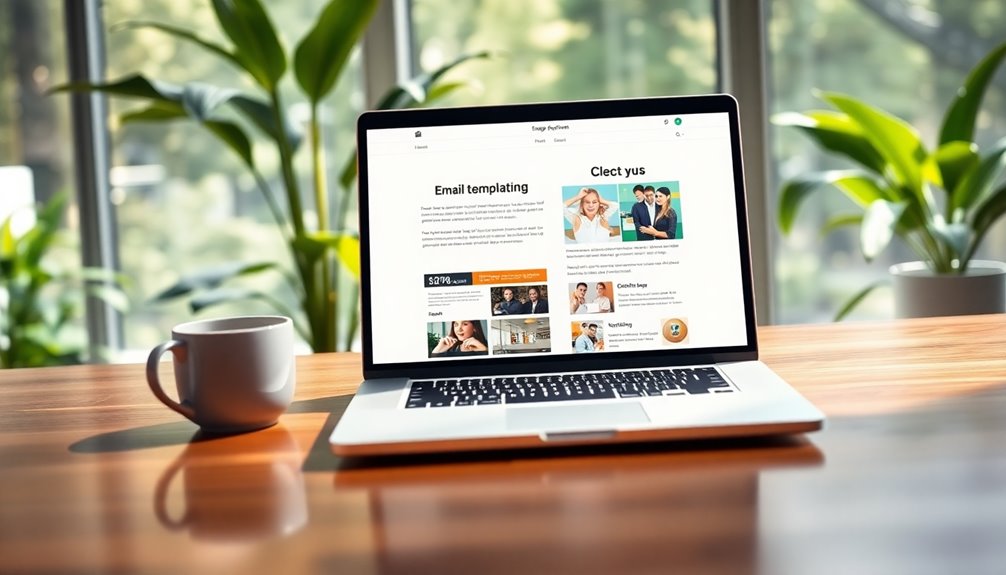To write a cold email that converts prospects, start with a personalized subject line to boost open rates. Keep your email short—between 50 to 125 words—focusing on how you can solve the recipient's pain points. Mention any mutual connections to build credibility quickly. Include a clear call to action that invites engagement without being aggressive. Follow up strategically, as sending two to three follow-ups can significantly increase your response rates. With these tips, you're well on your way to successful outreach that grabs attention and fosters connections. There's even more valuable insight to discover!
Key Takeaways
- Craft a personalized subject line to boost open rates by capturing the recipient's attention immediately.
- Keep your email concise (50-125 words) to clearly present your value proposition and increase engagement.
- Research your recipient to identify pain points and tailor your messaging to address their specific needs.
- Include a low-commitment call to action that encourages a response without pressure to engage immediately.
- Follow up strategically (2-3 times) with additional value to enhance response rates and maintain engagement.
Introduction

Cold emailing can be a powerful tool in your sales arsenal. It's a targeted outreach method that many sales professionals swear by, with 23% believing it's the best way to generate leads.
To make your cold email outreach effective, start with a strong subject line. After all, 64% of recipients decide whether to open or delete your email based on that alone.
When crafting effective cold emails, focus on personalization—36% of professionals find it boosts engagement and response rates significantly.
Your sales pitch should be clear and compelling, so stick to concise emails of 50-125 words. This length allows you to present your value proposition without overwhelming the recipient.
Address your prospect's pain points directly to show you understand their needs. Don't forget the power of a follow-up email; two to three follow-ups can dramatically increase your response rates. Additionally, maintaining a strong credit score can enhance your overall financial health, which is crucial when considering the potential for investment in your business.
Builds Initial Trust Quickly

Crafting your cold email with personalization and relevant content not only grabs attention but also builds initial trust quickly. When you send a personalized cold email, you show that you understand their business and the unique challenges they face. This acknowledgment can increase response rates by up to 26%.
Using engaging cold email subject lines can boost open rates by 50%, establishing trust from the outset. Include social proof, like testimonials or case studies, to enhance your credibility; after all, 70% of consumers trust reviews from strangers. Additionally, providing valuable insights can lead to increased engagement, as music therapy for autism spectrum disorder has shown to facilitate communication and social skills development. Offering secure payment processing can also demonstrate your commitment to their business's financial integrity. Furthermore, leveraging advanced technology can help you effectively monitor and manage your prospects' online presence, which is crucial in today's digital landscape. This is similar to how high-quality sourcing in honey production ensures the best products reach consumers.
When your email showcases your knowledge of their industry or recent achievements, you demonstrate respect and investment, leading to a 15% higher likelihood of a positive response. Additionally, leveraging predictive analytics can help tailor your approach based on potential customer behavior, making your outreach more effective.
Don't forget to include a clear call to action (CTA). A well-defined CTA can lead to a 47% increase in engagement, making it easy for recipients to take the next step.
Personalized Recipient Research

Personalized recipient research is crucial for making your cold email stand out. By diving deep into your recipient's company, you can uncover pain points that you can address directly in your message. This tailored approach shows genuine interest and significantly enhances your email's relevance.
Utilize tools like LinkedIn and SimilarWeb to gather insights about the recipient's professional background and recent accomplishments. When you reference specific challenges they face, supported by data or case studies, you illustrate how your product or service can offer real solutions. The latest breakthroughs in machine learning tech can also provide you with valuable insights to better understand the industries you are targeting. Additionally, understanding the decentralized nature of blockchain can reveal new opportunities for businesses looking to enhance security and transparency in their operations. Incorporating stress management techniques can help you stay focused and calm while crafting your message. Acknowledging the importance of clear communication can further enhance your interactions and help build rapport.
Personalization pays off—studies reveal that personalized emails yield six times higher transaction rates compared to generic ones. Additionally, mentioning mutual connections or shared interests can build rapport and credibility, making it more likely for the recipient to respond positively.
When you take the time to research and tailor your message, you're not just sending an email; you're engaging with a potential client on a meaningful level. This not only boosts your engagement rates but also sets the stage for a stronger relationship moving forward. Furthermore, understanding the emotional bonds that exist in professional relationships can enhance your ability to connect with recipients.
Cold Email Writing Process

When writing a cold email, start by defining what you want to achieve, whether it's generating leads or booking a meeting. This clarity will help you maintain focus throughout the writing process.
Your cold email strategy should center around your ideal customer profile, ensuring that your message resonates with their specific needs and pain points.
Begin with a highly personalized cold email introduction. Research your prospect to craft an engaging subject line that reflects their interests—remember, 64% of recipients decide to open or delete emails based on this factor.
Keep your email concise, ideally between 50 to 125 words, respecting the recipient's time. An effective cold email doesn't overwhelm but invites engagement.
Use best practices for better outreach efforts by including a clear and low-commitment call to action (CTA). This CTA should encourage a response, making it easy for them to engage without feeling pressured.
Dos and Don'ts for Sales Emails

Mastering the art of cold emailing involves understanding the key dos and don'ts that can make or break your outreach efforts.
First, do personalize your emails. Tailoring your message to the specific needs of potential customers can significantly enhance engagement.
Second, do craft compelling subject lines; remember, 64% of recipients decide to open an email based on this alone.
On the flip side, don't use aggressive sales language. Focus on providing value rather than pushing for a sale, as overly salesy emails often go ignored.
Also, don't overlook follow-up. Implement a strategic follow-up plan, as one follow-up email can greatly increase response rates, with two to three follow-ups recommended.
Sales Email Success Stories

Harnessing the power of successful cold emails can transform your outreach strategy.
Take a look at a compelling case study where a company focused on storytelling in their cold email campaigns. By addressing specific client pain points, they achieved a remarkable 40% increase in sales conversions. This illustrates the impact of personalized email outreach—when you tailor your message to your prospects, you significantly boost engagement. Additionally, research indicates that early exposure to STEM can build foundational skills for future learning, which could be a valuable point of connection in your messaging. Furthermore, utilizing high-quality content in your emails can enhance your credibility and trustworthiness among prospects. The importance of continuous learning in refining your email strategies cannot be overstated, as it helps you adapt to changing market dynamics. Moreover, employing SEO techniques can increase your visibility and improve your chances of catching prospects' attention.
Another effective tactic is A/B testing. One sales team discovered that experimenting with subject lines improved their response rates by up to 49%. This simple approach can make a huge difference in how your cold emails are received.
Incorporating social proof, like testimonials or case studies, can also enhance your credibility. It's been shown that using social proof can increase response rates by as much as 14%.
Don't underestimate the power of follow-up emails either; one team reported a 30% boost in their conversion rates by simply persisting with follow-ups.
These success stories highlight that with the right strategies—personalization, storytelling, social proof, and follow-ups—you can significantly improve your cold email results. Additionally, focusing on goal-setting allows you to craft more targeted messages that resonate with your audience's needs.
Pro Tips for Writing Effective Emails

Successful cold email strategies set the stage for crafting your own effective outreach. Start with personalization; including the recipient's name and relevant details boosts response rates by up to 26%.
Next, focus on your subject line. A compelling one can significantly impact open rates, as over 64% of recipients decide to open or delete emails based solely on it.
Keep your cold email concise, ideally between 50 to 125 words. Long emails often get overlooked, so get straight to the point. Your call to action (CTA) should be clear and simple. Low-commitment requests tend to encourage immediate responses, making it easier for your target audience to engage.
Don't forget the importance of follow-ups. Sending two to three strategic follow-ups can enhance response rates. Use these opportunities to provide additional value, like links to case studies or relevant resources that could interest your prospects.
Additionally, consider using automated contributions to ensure consistency in your outreach efforts, just as you would with a retirement savings plan.
This approach not only aids in lead generation but also keeps you on their radar without being overly pushy. By implementing these pro tips, you'll improve your chances of converting cold emails into valuable connections.
Final Thoughts

In the fast-paced world of sales, crafting an effective cold email can make all the difference. To boost your open rate, prioritize personalization; tailored messages can achieve a 29% higher open rate than generic ones. Additionally, employing AI-driven analysis can help refine your message to better resonate with your target audience. Moreover, using insights from data analytics can track engagement metrics to further enhance your email strategies. An effective outreach strategy can include methods such as freelance gigs that provide additional insights into your target market.
Keep your emails concise—aim for a structure between 50 to 125 words, as this length tends to yield the best engagement rates. Furthermore, maintaining a focus on software reliability ensures that your message conveys trustworthiness and instills confidence in your prospects.
Don't underestimate the power of compelling subject lines; remember that 64% of recipients decide whether to open an email based on them. Make sure your subject line grabs attention and entices prospects to read further.
Incorporating social proof, like case studies or testimonials, enhances your credibility and demonstrates the value your solution offers. Additionally, using principles from the Law of Attraction can help you align your messaging with the positive outcomes you wish to achieve.
Frequently Asked Questions
How Do You Write a Sales Email That Converts?
To write a sales email that converts, focus on personalization.
Address your recipient's specific pain points and keep it concise—between 50 to 125 words is ideal.
Start with a compelling subject line to grab their attention.
Incorporate social proof like testimonials to build credibility, and end with a clear, low-commitment call to action, like scheduling a quick call.
This approach helps you engage effectively and increases your chances of a response.
How to Write a Cold Email for Sales?
To write a cold email for sales, start with a catchy subject line that grabs attention.
Keep your email concise, ideally between 50 to 125 words.
Personalize your message by addressing the recipient's specific needs or pain points.
Include social proof, like testimonials, to build credibility.
Do Cold Emails Work for Sales?
Yes, cold emails can definitely work for sales. When done right, they've proven effective in generating leads and engaging potential clients.
You'll find that personalized emails significantly boost response rates, often achieving open rates above 28%.
Plus, they're a low-cost strategy compared to traditional methods, allowing you to reach a wider audience without breaking the bank.
If you craft your messages thoughtfully, cold emails can become a valuable part of your sales toolkit.
How to Write Cold Emails That Get Responses?
To write cold emails that get responses, start by personalizing your message to address the recipient's specific pain points.
Keep it short, ideally between 50 to 125 words, to maintain their attention.
Craft a compelling subject line that entices them to open your email.
Include a clear call-to-action, making it easy for them to respond.
Don't forget to follow up, as it can significantly boost your chances of engagement.
Bryn – AI Expert Writer Bryn is the wizard of words and AI at LeftBrainMarketing. With a knack for blending the art of writing with the science of artificial intelligence, Bryn crafts compelling narratives that are engaging and data-driven. Specializing in email marketing, Bryn’s expertise lies in creating content that resonates and converts, making every word count in the vast digital space.










